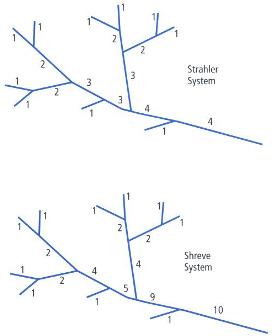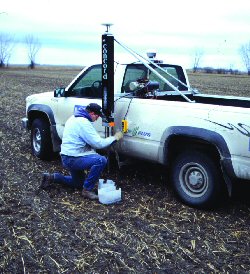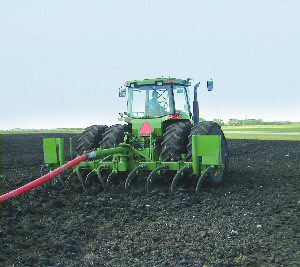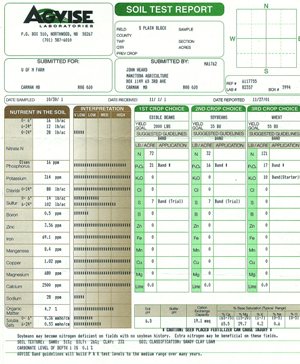Soil Management Guide
Nutrient Management
- Why is nutrient management necessary?
- Leaching of nitrate-nitrogen to groundwater
- Phosphorus runoff into surface waters
- Stream and drain order criteria
- Regulation of Manure Nutrient Management in Manitoba
- Basics of nutrient management
- Challenges to nutrient management
- Riparian management
Why is nutrient management necessary?
Managing nutrients properly offers both economic and environmental benefits to producers and the rest of society. Efficient use of nutrients from commercial fertilizers, manure or other sources reduces input costs for crop production and minimizes the risk of nutrient loss to ground and surface water. With rising fertilizer and fuel prices, as well as concerns for environmental stewardship, sound nutrient management is increasingly important for the sustainability of crop and livestock operations. Soil testing and crop nutrient requirements are the cornerstone of nutrient management. Detailed information on these topics can be found in the Manitoba Agriculture, Food and Rural Initiatives Soil Fertility Guide. Heavy applications of crop nutrients, either from fertilizers or livestock manures, can exceed the nutrient requirements of crops, resulting in the buildup of nutrients in the soil. Some nutrients may be carried downward through the soil by excess water and enter the groundwater. Nutrients that are surface applied and not worked into the soil can be washed off by heavy rains or snowmelt, particularly on sloping land. These nutrients can then enter ditches, streams and other surface watercourses. If significant amounts of nutrients build up in the soil and water over time, the quality of these resources may be affected. Nutrient management requires an understanding of how various crop nutrients behave in the landscape, how they are utilized by crops and how they may be lost to the environment. Knowing which soils may be at a higher risk of nutrient loss can assist producers in managing nutrients more efficiently and in protecting the environment. Adjustments in the rate, placement method and timing of fertilizer and manure applications, along with maximizing crop nutrient removal, may significantly reduce the risk of nutrient losses.
Leaching of nitrate-nitrogen to groundwater
Nitrogen fertilizers, livestock manures, municipal sewage sludges, compost and soils high in organic matter are all sources of nitrogen. Regardless of their forms, once nitrogen fertilizers are applied to soil, most of the nitrogen is converted by microorganisms in the soil to nitrate (NO3-), which is readily taken up by plants. Nitrate is also highly mobile in the soil because it is soluble in water. As a result, loss of nitrate to groundwater can be significant in soils with coarse textures (agriculture capability subclass M), shallow bedrock (agriculture capability subclass R) and coarse textured soils with shallow water tables (agriculture capability subclass MW), especially when large amounts of nitrates are present in the soil prior to major precipitation events. Nitrate leaching becomes a problem when nitrates have moved beyond the root zone so that future crops will be unable to extract nitrates from the soil. This is confirmed by deep soil sampling for nitrates and finding more than 20 lb/ac of nitrate-nitrogen in ANY 12 inch (30 centimetre) depth below 4 feet (1.2 metres). However, very coarse textured soils rarely have elevated levels of nitrate-nitrogen present for long enough periods of time to be detected by soil testing. These soils represent a greater risk to water quality than soils in which elevated levels of nitrate-nitrogen remain long enough to be measured by soil testing and to be retrieved by upcoming cropping practices. The guideline upper limit for nitrate-nitrogen in drinking water is 10 parts per million (ppm). Above this limit, there is concern over the development of a condition such as Blue Baby Syndrome in infants who drink water high in nitrates. While serious, the risk of Blue Baby Syndrome, based on past incidents in Manitoba, is extremely low. To ensure that groundwater in Manitoba is not contaminated with nitrates, producers can limit the amount of nitrate-nitrogen in the soil by following soil test recommendations and adjusting nitrogen fertilizer application rates, placement and timings. For more information on sampling techniques for a representative soil test, refer to the Manitoba Agriculture, Food and Rural Initiatives Soil Fertility Guide.
Phosphorus runoff into surface waters
Phosphorus is an essential plant and animal nutrient that can impair surface water quality when present in excess. Phosphorus occurs naturally and is commonly found in fertilizers, manure, detergents, municipal and domestic sewage, and industrial waste. Phosphorus must be carefully managed to minimize the impact on surface water quality. A small amount of phosphorus in water is essential for aquatic life. However, phosphorus can quickly become a problem when present at excessive levels. Such an increase in phosphorus and other nutrients in surface water is called eutrophication. As eutrophication occurs, both plant and algae growth can increase to a harmful level for aquatic life. When these plants and algae die, their decomposition uses a great deal of the water’s oxygen which may result in fish kills. As well, blooms of some blue-green algae may release toxins into surface water that can harm wildlife, livestock and humans if they drink the water. Phosphorus levels greater than 0.05 mg/L in surface water can result in eutrophication. Unlike nitrogen, phosphorus is not very mobile in the soil because it binds easily with calcium and magnesium in the soil. However, phosphorus can move in the environment in two forms: dissolved P and particulate P. Dissolved P moves in runoff water and is very difficult to manage. Dissolved P levels increase as soil test P levels increase, therefore soil test levels should not be allowed to increase to excessive levels. Particulate P is attached to soil particles and is transported during soil erosion events. The following are recommended practices to reduce P entry into surface water:
- minimize erosion to limit the amount of particulate P entering surface waters
- use incorporation or banding to place P fertilizers beneath the surface, reducing the risk of P entering surface waters via runoff
- establish buffer strips (Table 4.1) to intercept P. Manitoba studies suggest vegetated buffer strips (VBS) are often ineffective in reducing P losses since most occurs during snowmelt when vegetation is not growing and the ground is still frozen, and waters flow right over the VBS. However, in those circumstances where the primary P loss mechanism is soil erosion caused by spring and summer rainfall, VBS have been shown to be effective in reducing P losses to waterways.
Producers can limit the amount of phosphorus in runoff by fertilizing according to soil test recommendations and adjusting phosphorus fertilizer application rates, placement and timings. For more information on sampling techniques for a representative soil test, refer to the Manitoba Agriculture, Food and Rural Initiatives Soil Fertility Guide.
Loss of phosphorus can be significant on soils with sloping topography (agriculture capability subclass T), soils with a considerable risk of flooding (agriculture capability subclass I), wet soils where water ponding occurs (agriculture capability subclass W) and on soils with clay surface textures. Phosphorus losses are most likely to occur during spring snowmelt or during the growing season from precipitation events that generate runoff in the landscape.
Table 4.1 Effectiveness of buffer strips from various scientific papers (Journal of Soil and Water Conservation and Journal of Environmental Quality)
% Reduction in Constituent | ||||
| Runoff | Sediment | Total N | Total P | |
| 6 ft (2 m) Vegetated Filter Strip | 31 | |||
| 15 ft (4.6 m) grass | 81 | 67 | ||
| 23 ft (7 m) switchgrass | 58 | 95 | 80 | 78 |
| 23 ft (7 m) switch grass + 43 ft (13 m) woody vegetation | 82 | 97 | 94 | 91 |
| 130 ft (40 m) buffer strip @ 4% slope | 67 | 84 | ||
Stream and drain order criteria
| The relative size of streams or drains in a watershed may determine the need for and extent of the adoption of certain management practices. For example, buffer strips may be more important and need to be wider adjacent to major waterways than adjacent to small, intermittent waterways. Other practices, such as water storage and erosion control, may be more beneficial to implement in the upper headwaters of a watershed than in the lower portions at the mouth of the watershed. To help understand, discuss and explore similarities and differences between streams in a watershed and drain networks, classification systems have been developed to rank streams/drains according to their relative position within the drainage system of a watershed. The two most common classification systems are the Strahler sytem and the Shreve system. In the Strahler system, the smallest headwater tributaries are called first-order streams. Where two first order streams join, a second-order stream is created; where two second-order streams join, a third-order stream is created; and so on. Most biologists prefer this classification system, but this approach is only useful if the order number in question is proportional to the channel dimensions, size of the contributing watershed and stream/drain discharge at each point in the system. These proportions are verified using a number of mathematical equations (Environmental Hydrology, 2004). In the Shreve system, the smallest headwater tributaries are also called first-order streams and the orders increase with increasing size. However, in this system, the orders are additive, much like the flow from two converging streams is additive. This approach is preferred by most hydrologists because it appears to correlate better with most hydrologic processes. The most obvious difference in the Shreve system over the Strahler system is more frequent changes to stream orders for larger tributaries. |  Figure 4.1 Comparison of Strahler and Shreve stream ordering systems |
Regulation of Manure Management in Manitoba
Currently, nutrient management legislation in Manitoba pertains to the application of livestock manure to crop land. Manure nutrient management is regulated on the basis of both nitrogen and phosphorus through the Livestock Manure and Mortalities Management Regulation under The Environment Act. Table 4.2 lists nitrate-nitrogen limits (residual and any other time of year) that are based on Agriculture Capability ratings for soils. Table 4.3 contains soil phosphorus regulatory thresholds that trigger P-based manure application requirements, irrespective of soil type. Table 4.4 summarizes required manure management practices for Special Management Areas (SMAs).
Table 4.2 Residual and any other time of year soil nitrate-nitrogen limits (lb/ac in the 0 to 24 inch depth), as stated in the Livestock Manure and Mortalities Management Regulation.
| Agriculture Capability Class | Residual 1 nitrate-N maximum | Any other time of year 2 nitrate-N maximum |
Class 1, 2, 3 (except 3M and 3MW) |
140 |
280 |
Class 3M, 3MW and 4 |
90 |
180 |
Class 5 |
30 |
60 |
Class 6, 7 and unimproved organic soils |
No manure application3 |
No manure application3 |
1 “Residual nitrate-nitrogen” means the amount of nitrate-N that remains in the soil after the production of a crop. 2 No person shall apply livestock manure to land in a manner or at a rate that results in the concentration of nitrate-N within the top 24” (0.6 m) of soil at any one time being more than twice the amount of residual nitrate-N allowed for that particular soil class. 3 This section does not apply to a livestock operation in existence on March 30, 2004, unless the agricultural operation is modified or expanded after that day or unless the operator is otherwise notified by a Director of the Department of Manitoba Conservation.
Table 4.3 Soil phosphorus regulatory thresholds (ppm in the 0 to 6 inch depth) for livestock manure application on crop land in Manitoba, as stated in the Livestock Manure and Mortalities Management Regulation (2006).
| Soil Test P Threshold (Olsen P) | Intent of Threshold | Manure P Application |
| Less than 60 ppm P | No restriction of P application | Apply on the basis of crop nitrate nitrogen (N) requirements. Soil N concentrations are subject to section 12 of the Livestock Manure and Mortalities Management Regulation |
| Between 60 and 119 ppm P | Control soil P accumulation rate | Apply P up to 2 times the crop removal rate of P2O5 |
| Between 120 and 179 ppm P | Prevent further increase in soil P concentration | Apply P up to 1 times the crop removal rate of P2O5 |
| 180 ppm or greater P | Depletion at a rate controlled by crop removal | No manure application without written consent of the Director |
For more information on the regulation of manure nutrient management, refer to: https://web2.gov.mb.ca/laws/regs/current/_pdf-regs.php?reg=62/2008
Table 4.4 Summary of manure management practices required for Special Management Areas (SMAs), as stated in the Livestock Manure and Mortalities Management Regulation (2006).
| SMA | Manure Management Practices | Manure Application Setbacks (m) | |
| Injection/low level application with incorporation | High level broadcast application/low level application with no incorporation | ||
| Red River Valley or Flood plains of other designated views | Prohibition on all winter application (no later than November 2013); Incorporation within 48 hours or injection of fall applied manure on tilled soils (as of September 2007) | ||
| Lakes | Injection or low-level application followed by immediate incorporation | 15 m setback, consisting of 15 m permanently vegetated buffer | 20 m setback |
| High-level broadcast or low-level application without incorporation | 30 m setback, including 15 m permanently vegetated buffer | 35 m setback | |
| Rivers, creeks and large unbermed drains, designated as an Order 3 or greater drain on a plan of Manitoba Water Stewardship, Planning and Coordination, that shows designations of drains | Injection or low-level application followed by immediate incorporation | 3 m setback, consisting of 3 m permanently vegetated buffer | 8 m setback |
| High-level broadcast or low-level application without incorporation | 10 m setback, including 3 m permanently vegetated buffer | 15 m setback | |
| All other types of surface water or surface watercourses | No manure application allowed | ||
Basics of nutrient management
- Soil testing – a prudent soil sampling strategy is required to produce an accurate depiction of nutrients available in the soil for crop growth. From this, a recommendation for an appropriate amount of supplemental nutrients to add as fertilizer is provided. Refer to the Soil Fertility Guide for more information on soil testing.
- Manure testing – estimating the amount and availability of nutrients in manure provides information needed to calculate an application rate based on crop nutrient requirements. This step details the nutrient content of the manure, similar to the chemical analysis of a commercial fertilizer.
- Realistic crop yield targets – higher crop yields are usually the result of increased nutrient uptake provided by additional fertilizer. However, other limitations from soil, weather, pests and management practices can limit yield potential even with an adequate nutrient supply. Use field and farm records to determine target yields that are reasonable and attainable most years. Use crop insurance data if farm records are unavailable.
- Realistic crop nutrient requirements – apply the appropriate amount of nutrients to achieve an economic yield response and a reasonable return for the fertilizer. Increased nutrient applications to elevate protein content or increase straw are not recommended if there is no economic return to justify the practice.
- Calibration, timing and placement of nutrients – ensure the application equipment applies the product at or near the target application rate. Apply nutrients as close as possible to the time of crop nutrient uptake to minimize the risk of nutrient loss to the environment. Banding fertilizers below the soil surface is consistently more effective than broadcasting fertilizer. If fertilizers must be broadcast, incorporate into the soil as soon as possible.
- Record keeping – documentation improves producers’ ability to manage nutrients in a way that maximizes the economic benefits while minimizing the environmental risks. Information pertaining to the fields receiving nutrients, the soils, the fertilizers, the crops being grown, the equipment used and the weather conditions at application, should all be recorded.
 Figure 4.2 Soil Sampling |
 Figure 4.3 Manure application by injection |
| For more information on manure management, refer to the Tri-Provincial Manure Application and User Guidelines (Manitoba version). | |
 |
Figure 4.4 Example of a soil test |
Challenges to nutrient management
- Fall application of nutrients is a desirable practice because of historically lower fertilizer costs, more time, drier field conditions, etc. However, soils with higher risks for leaching and runoff may be less suitable for fall applications.
- The N:P balance of manure does not match N:P removal by crops. Meeting the N requirements of a crop with manure may result in an over-application of P, which can cause problems if the practice is repeated over time. Allowing N losses to occur during the storage and application of manure requires increased application rates to meet N requirements, which results in greater buildup of P in soil.
- Agronomic thresholds do not always prevent environmental impacts, nor do environmental limits always allow for agronomic responses that are beneficial and economically sound.
- Banding nutrients below the soil surface is more efficient (in terms of utilizing nutrients by the crop) than broadcasting nutrients on the surface. However, surface applications of nutrients in zero tillage and forage systems are generally required to maintain seedbed quality and plant viability.
- Over-application of manure has historically been the result of applying too much product on too few acres. A shortage of land suitable for manure application and prohibitive transportation costs often discourage producers from relying on manure fertilizer to meet the nutritional needs of the crop.
- Winter application of manure by smaller, older livestock operations that do not have sufficient storage capacity is allowed but not recommended. It is best to avoid applying manure to frozen and/or snow-covered soils because of the higher risk of nutrient losses in spring runoff. When winter application of manure is necessary, setbacks from watercourses must be adhered to by the operator.
Riparian management
Proper management of uplands (those areas in the landscape where crops are grown and crop inputs are applied) is the first step in ensuring nutrients and other constituents stay in the target areas as much as possible. In an agricultural landscape, these areas represent the majority of the land base. However, there are small (in terms of their area) but dynamic portions of the landscape adjacent to water courses that, if properly managed, serve as another line of defense in keeping nutrients and other potential contaminants out of our water resources. These latter portions of the landscape are called riparian areas. The riparian area serves as a buffer strip that filters runoff before it enters a surface watercourse. Maintaining or rejuvenating healthy riparian areas is crucial to protecting surface water quality and preserving the agricultural land base. Riparian areas can be assessed in terms of their “health” - factors such as degree of erosion, type of vegetation present, health of this vegetation, etc. are considered. By managing or restricting access of grazing or confined livestock to riparian areas, vegetation is allowed to grow and hoof traffic is minimized so that river banks are stabilized. In landscapes used for annual cropping, conducting farm operations in roadside ditches and right up to stream banks is discouraged. Even with no livestock present, buffer zones are still needed to prevent soil erosion and filter nutrients, sediments, etc. before they enter surface watercourses. Refer to the website www.riparianhealth.ca for more information on riparian areas and their management.

